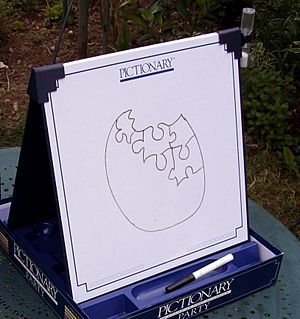Pictionary facts for kids
Pictionary is a charades-inspired word-guessing game invented by Robert Angel with graphic design by Gary Everson and first published in 1985 by Angel Games Inc. Angel Games licensed Pictionary to Western Publishing. Hasbro purchased the rights in 1994 after acquiring the games business of Western Publishing. Mattel acquired ownership of Pictionary in 2001. The game is played in teams with players trying to identify specific words from their teammates.
Objective
Each team moves a piece on a game board formed by a sequence of squares. Each square has a letter or shape identifying the type of picture to be drawn on it. The objective is to be the first team to reach the last space on the board. To achieve this a player must guess the word or phrase being drawn by their partner, or if the player lands on an "all play" square, one player from each team attempts to illustrate the same concept simultaneously, with the two teams racing to guess first. The first player to land and guess correctly at the finish wins.
Gameplay
The team chooses one person to begin drawing; this position rotates with each word. The drawer chooses a card out of a deck of special Pictionary cards and tries to draw pictures which suggest the word printed on the card. The pictures cannot contain any numbers or letters, nor can the drawers use spoken clues about the subjects they are drawing. The teammates try to guess the word the drawing is intended to represent.
There are five types of squares on the board, and each Pictionary card has a list of five words printed on it. Players must then draw the word which corresponds to the square on the board on which the team's marker is:
| Subject | |
|---|---|
| P | Person/Place/Animal |
| O | Object |
| A | Action |
| D | Difficult (words which are difficult to represent in a drawing) |
| AP | All Play |
| Appears in certain versions. Player may pick a card and choose which word they wish to draw from the five given. |
AP category (and a random selection of check-marked words in other categories) are designated as "All Play". For "All Play," the teams compete against each other. Each team designates a player whose purpose will be to draw pictures. The team that guesses the word first gets to advance and take the next turn. If none of the teams guess the word, the turn passes to whichever team should have been next. One may not point or gesture to an object
A one-minute timer, usually a sand timer, is used to compel players to rapidly complete their drawing and guessing.
See also
 In Spanish: Pictionary para niños
In Spanish: Pictionary para niños


